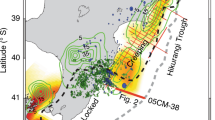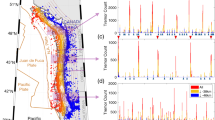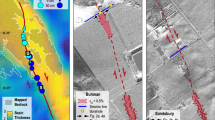Abstract
Viscous flow in the deep crust and uppermost mantle can contribute to the accumulation of strain along seismogenic faults in the shallower crust1. It is difficult to evaluate this contribution to fault loading because it is unclear whether the viscous deformation occurs in localized shear zones or is more broadly distributed2. Furthermore, the rate of strain accumulation by viscous flow has a power law dependence on the stress applied, yet there are few direct estimates of what the power law exponent is, over the long term, for active faults. Here we measure topography and the offset along fault surfaces created during successive episodes of slip on seismically active extensional faults in the Italian Apennines during the Holocene epoch. We show that these data can be used to derive a relationship between the stress driving deformation and the fault strain rate, averaged over about 15 thousand years (kyr). We find that this relationship follows a well-defined power law with an exponent in the range of 3.0–3.3 (1σ). This exponent is consistent with nonlinear viscous deformation in the deep crust and, crucially, strain localization promoted by seismogenic faulting at shallower depths. Although we cannot rule out some distributed deformation, we suggest that fault strain and thus earthquake recurrence in the Apennines is largely controlled by viscous flow in deep, localized shear zones, over many earthquake cycles.
This is a preview of subscription content, access via your institution
Access options
Subscribe to this journal
Receive 12 print issues and online access
$259.00 per year
only $21.58 per issue
Buy this article
- Purchase on Springer Link
- Instant access to full article PDF
Prices may be subject to local taxes which are calculated during checkout




Similar content being viewed by others
References
Thatcher, W. Nonlinear strain build up and the earthquake cycle on the San Andreas Fault. J. Geophys. Res. 88, 5893–5902 (1983).
Bürgmann, R & Dresen, G. Rheology of the lower crust and upper mantle: Evidence from rock mechanics, geodesy and field observations. Annu. Rev. Earth Planet. Sci. 36, 531–567 (2008).
Kenner, S. J. & Simons, M. Temporal clustering of major earthquakes along individual faults due to post-seismic reloading. Geophys. J. Int. 160, 179–194 (2005).
Freed, A. M. Earthquake triggering by static, dynamic and postseismic stress transfer. Annu. Rev. Earth Planet Sci. 33, 335–367 (2005).
Carter, N. L. & Tsenn, M. C. Flow properties of continental lithosphere. Tectonophysics 136, 27–63 (1987).
Newman, R. & White, N. The dynamics of extensional sedimentary basins: Constraints from subsidence inversion. Phil. Trans. R. Soc. Lond. 357, 805–830 (1999).
Freed, A. M. & Bürgmann, R. Evidence of power law flow in the Mojave Desert mantle. Nature 430, 548–551 (2004).
Handy, M. R., Hirth, G. & Bürgmann, R. in Tectonic Faults: Agents of Change on a Dynamic Earth (eds Handy, M. R., Hirth, G. & Hovius, N.) 139–181 (MIT Press, 2007).
Faure Walker, J. P., Roberts, G. P., Sammonds, P. R. & Cowie, P. A. Comparison of earthquake strains over 102 to 104 year timescales: Insights into variability in the seismic cycle in central Apennines, Italy. J. Geophys. Res. 115, B10418 (2010).
Roberts, G. P. & Michetti, A. M. Spatial and temporal variations in growth rates along active normal fault systems: An example from The Lazio–Abruzzo Apennines, central Italy. J. Struct. Geol. 26, 339–376 (2004).
Faure Walker, J. P. et al. Relationship between topography and strain rate in the actively extending Italian Apennines. Earth Planet. Sci. Lett. 325/326, 76–84 (2012).
D’Agostino, N., Jackson, J., Dramis, F. & Funiciello, R. Interactions between mantle upwelling, drainage evolution and active normal faulting: An example from the central Apennines (Italy). Geophys. J. Int. 147, 475–497 (2001).
D’Anastasio, E. et al. Short-term vertical velocity field in the Apennines (Italy) revealed by geodetic levelling data. Tectonophysics 418, 219–234 (2006).
D’Agostino, N. et al. Evidence for localized active extension in the central Apennines (Italy) from global positioning system observations. Geology 39, 291–294 (2011).
Della Vedova, B., Bellani, S., Pellis, G. & Squarci, P. in Anatomy of an Orogen: The Apennines and adjacent Mediterranean Basins (eds Vai, G. B. & Martini, I. P.) 65–76 (Kluwer Academic, 2001).
England, P. & Molnar, P. Late Quaternary to decadal velocity fields in Asia. J. Geophys. Res. 110, B12401 (2005).
Flesch, L. & Bendick, R. The relationship between surface kinematics and deformation of the whole lithosphere. Geology 40, 711–714 (2012).
Naliboff, J. B., Lithgow-Bertolloni, C., Ruff, L. J. & de Koker, N. The effects of lithospheric thickness and density structure on Earth’s stress field. Geophys. J. Int. 188, 1–17 (2008).
Boncio, P., Tinari, D. P., Lavecchia, G., Visini, F. & Milana, G. The instrumental seismicity of the Abruzzo Region in Central Italy (1981–2003): Seismotectonic implications. Ital. J. Geosci. (Boll. Soc. Geol. Ita.) 128, 367–380 (2009).
Jaeger, J. C. & Cook, N. G. Fundamentals of Rock Mechanics 2nd edn (Chapman & Hall, 1979).
Chiarabba, C. & 28 co-authors, The 2009 L’Aquila (central Italy) Mw6.3 earthquake: Main shock and aftershocks. Geophys. Res. Lett. 36, L18308 (2009).
Huismans, R. S. & Beaumont, C. in Imaging, Mapping and Modelling Continental Lithosphere Extension and Breakup Vol. 282 (eds Karner, G. D., Manatschal, G. & Pinhiero, L. M.) 107–134 (Geol. Soc. Lond. Spec. Pub., 2007).
Fusseis, F., Handy, M. R. & Schrank, C. Networking of shear zones at the brittle-to-viscous transition (Cap de Creus, NE Spain). J. Struct. Geol. 28, 1228–1243 (2006).
Ellis, S. & Stöckhert, B. Imposed strain localization in the lower crust on seismic timescales. Earth Planet. Space 56, 1103–1109 (2004).
Mehl, L. & Hirth, G. Plagioclase recrystallization and preferred orientation in layered mylonites: Evaluation of flow laws for the lower crust. J. Geophys. Res. 113, B05202 (2008).
Hirth, G., Teyssier, C. & Dunlap, W.J. An evaluation of quartzite flow laws based on comparisons between experimentally and naturally deformed rocks. Int. J. Earth Sci. 90, 77–87 (2001).
Platt, J. P. & Behr, W. M. Grainsize evolution in ductile shear zones: Implications for strain localisation and the strength of the lithosphere. J. Struct. Geol. 33, 537–550 (2011).
Gliozzi, E. & Mazzini, I. Paleoenvironmental analysis of Early Pleistocene brackish marshes in the Rieti and Tiberino intraappenninic basins (Latium and Umbria, Italy) using ostracods (Crustacea). Palaeogeogr. Palaeoclimatol. Palaeoecol. 140, 325–333 (1998).
Mancini, M., D’Anastasio, E., Barbieri, M. & De Martini, P-M. Geomorphological, paleontological and 87Sr/86Sr isotope analyses of early Pleistocene paleoshorelines to define the uplift of Central Apennines (Italy). Quat. Res. 67, 487–501 (2007).
Roberts, G. P., Michetti, A., Cowie, P. A., Morewood, N. C. & Papanikolaou, I. Fault slip-rate variations during crustal-scale strain localisation, Central Italy. Geophys. Res. Lett. 29, 9-1–9-4 (2002).
Acknowledgements
N. D’Agostino supplied the long-wavelength topography data used in Figs 2 and 4. This work was supported by NERC grants: NER/S/A/2006/14042, NE/E01545X/1 and NE/I024127/1. Financial support was also provided by the Statoil Earth System Modelling project (P.S.) and the Statoil-University of Bergen Akademia agreement (P.A.C.). We thank R. Huismans for discussions and P. Molnar and M. Handy for their comments.
Author information
Authors and Affiliations
Contributions
P.A.C. led the interpretation of the scaling exponent in terms of mid-crustal shear zones. C.H.S. contributed to understanding the behaviour of coupled frictional–viscous fault systems. G.P.R. provided the structural data and analysed the strain rate versus elevation relation. J.P.F.W. carried out the strain rate calculations and quantified data uncertainties. P.S. contributed to understanding stress and strain rate variations in a layered lithosphere.
Corresponding author
Ethics declarations
Competing interests
The authors declare no competing financial interests.
Supplementary information
Supplementary Information
Supplementary Information (PDF 1533 kb)
Rights and permissions
About this article
Cite this article
Cowie, P., Scholz, C., Roberts, G. et al. Viscous roots of active seismogenic faults revealed by geologic slip rate variations. Nature Geosci 6, 1036–1040 (2013). https://doi.org/10.1038/ngeo1991
Received:
Accepted:
Published:
Issue Date:
DOI: https://doi.org/10.1038/ngeo1991
This article is cited by
-
Surface faulting earthquake clustering controlled by fault and shear-zone interactions
Nature Communications (2022)
-
Stress loading history of earthquake faults influenced by fault/shear zone geometry and Coulomb pre-stress
Scientific Reports (2020)
-
Coulomb pre-stress and fault bends are ignored yet vital factors for earthquake triggering and hazard
Nature Communications (2019)
-
Future stress accumulation zones around the main active faults by 3D numerical simulation in East Azerbaijan Province, Iran
Acta Geodaetica et Geophysica (2019)
-
The velocity field of the Italian area
Rendiconti Lincei. Scienze Fisiche e Naturali (2018)



